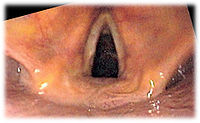
Photo from wikipedia
Abstract Background Video-laryngoscopy has proven valuable in management and training of difficult airways. We evaluate the Yann tube, a novel bi-directional articulable endotracheal tube and video stylet combination, together with… Click to show full abstract
Abstract Background Video-laryngoscopy has proven valuable in management and training of difficult airways. We evaluate the Yann tube, a novel bi-directional articulable endotracheal tube and video stylet combination, together with video-laryngoscopy in a simulation setting to determine if it improves management and education of difficult airways. Methods We evaluated the Yann tube (with video-laryngoscopy) against direct and video-laryngoscopy alone across four simulated airway scenarios, and measured time and attempts to successful intubation, percentage-of-glottic-opening (POGO) score, and Cormack-Lehane grading. Afterward, we surveyed participant subjective experiences. Results There were 32 participants of varying experience. Pharyngeal obstruction was the only airway scenario where the Yann tube was significantly slower than video-laryngoscopy alone (37s vs 27s; p Conclusions Although the Yann tube did not significantly improve successful first pass intubation, it did not significantly take longer to perform, and improved airway visualization in certain difficult airway scenarios. The use of simulation also enhanced education and understanding of airway anatomy for novice intubators.
Journal Title: Trends in Anaesthesia and Critical Care
Year Published: 2020
Link to full text (if available)
Share on Social Media: Sign Up to like & get
recommendations!